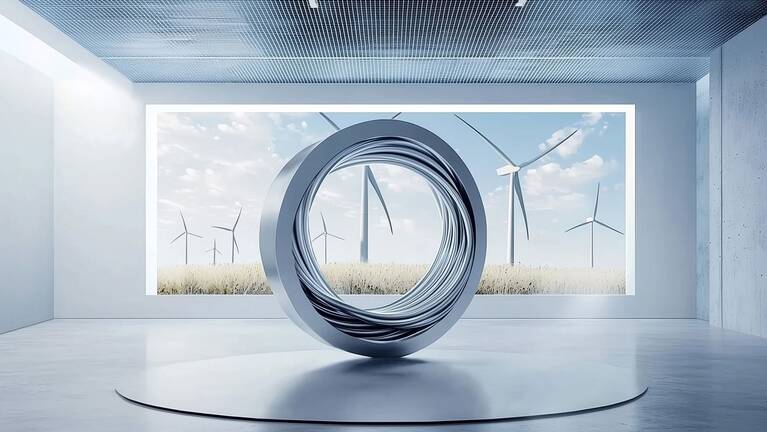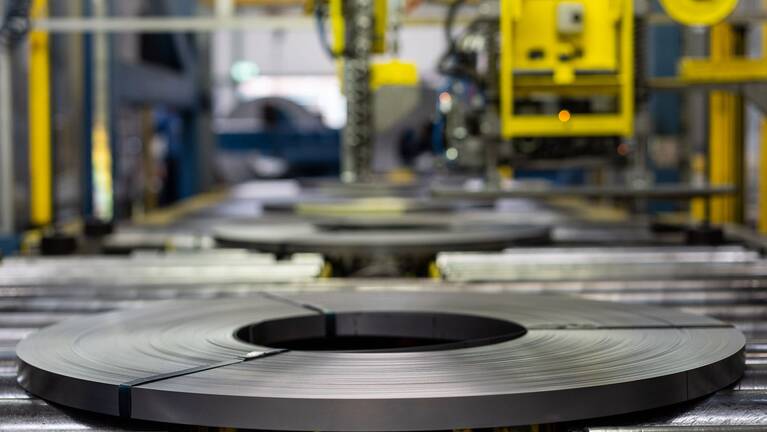Wind power plays a significant role in the energy transition and the associated expansion of renewable energy sources. During wind turbine operation, tremendous forces need to be transmitted from the rotor blades to the generator to produce electricity. High peak loads due to changing wind speeds, which can lead to a dynamic misalignment in the drive train of up to three degrees between the gearbox and the generator, represent one of the particular challenges in this respect. Special clutches are used to compensate for this misalignment in order to avoid the resulting loss of efficiency and damage and to ensure that the systems operate as reliably and with as little wear as possible. Waelzholz supplies a custom-designed, martensitic hardened and tempered steel strip with outstanding mechanical and technological properties and unparalleled flatness for large cross sections with a thickness of up to 4.50 millimeters for the steel plates of these clutches.
Clutch plates made of martensitic hardened and tempered steel strip for reliable power transmission in wind turbines
The power of the wind was harnessed more than two thousand years ago by simple wind turbines made of wood and cloth for the purpose of grinding grain or irrigating fields. Today, wind plays an essential role in sustainable power generation from renewable sources. The technology used to generate energy from wind power has advanced significantly, especially since the turn of the millennium. Modern wind turbines are complex, computer-controlled, large-scale power generation systems and can be found spinning in numerous countries around the world. China, the United States, and Germany lead in terms of the number of installed systems, followed by India and Spain.
Global installed wind power capacity has increased over the past twenty years from 24 gigawatts to 837 gigawatts in 2021. Although wind turbines currently cover only about 7 % of global electricity demand, studies forecast a possible increase to up to 20 % by 2030. In fact, capacity could grow to more than 3,000 gigawatts by 2050, covering one-third of global energy needs. Alongside solar power, wind power therefore plays a key role in reducing carbon emissions from energy generation and is an important component and growth market for a climate-neutral future.
High-tech materials to increase the performance of modern wind turbines
To further increase the share of wind power in the climate-neutral energy mix, modern wind turbines already have to be extremely powerful, efficient, and reliable in operation. The desired increase in the energy output of a turbine from around six to up to ten megawatts requires, among other changes, a further increase in the size of the rotor blades. Even the drive trains of current turbines with rotor blades about 60 meters long already have to transmit torques of up to 500,000 newton meters (Nm) – an output equivalent to that of more than 1,500 modern mid-size cars. As wind turbines continue to grow, so too will the demands placed on the power transmission and energy generation components, and therefore also on the steel materials used. This is precisely why Waelzholz already develops and manufactures custom-designed high-tech materials – its highly efficient electrical steel strip isn’t the only material used in wind turbines’ high-performance generators. We also supply martensitic hardened and tempered steel strip with special technological properties for the clutch plates installed in the drive train clutch.
Multi-plate clutches for safe power transmission and reliable generator protection
“The special loads that act upon a wind turbine’s drive system are caused by changing wind speeds and wind directions, such as those caused by gusts of wind, which can affect the rotor blades in different ways. These forces mean that the drive train can be subjected to relative movements – i.e., a dynamic misalignment – of up to three degrees. For this reason, the gearbox and generator are mounted on elastic dampers,” explains Dennis Domaschk from the Waelzholz sales team. If this shaft misalignment was transmitted to the generator despite the dampers, it could cause serious damage. In light of the effort and costs involved in maintaining or repairing onshore and offshore wind turbines, we developed high-performance steel clutch plates that reliably absorb this movement and therefore protect the generator.
Klaus Neumeyer from materials technology explains: “The clutch in wind turbines has four lamination stacks on each side that are combined to form a diamond shape. Multiple layers of the lamination stack, some of which have different thicknesses, provide additional axial stiffness. The rhombus made of steel plates is alternately connected at its corners to the gearbox or generator shaft and to the clutch shaft.” This creates what is known as a double cardan suspension on each side of the coupling, which compensates for the shaft misalignment between the gearbox and the generator during operation. The steel material used for this purpose must meet the highest standards when it comes to tensile strength and stiffness.
A sustainable solution: financial advantages in the manufacturing process and maximum efficiency in renewable power generation
Materials from Waelzholz are always designed with an eye to achieving the best possible processing properties, thereby offering customers financial advantages in their own manufacturing processes. “The martensitic hardened and tempered steel strip we supply can, for example, eliminate the need for costly and time-consuming piece hardening at our customers’ facilities. Possible deformation due to hardening the individual parts can also be avoided with our material in view of the high standards of flatness required,” says sales specialist Domaschk.
“Solving challenging tasks for our customers is our key area of expertise,” Neumeyer reports. “That’s why we’ve also perfectly tailored this high-performance material to the individual requirements of the wind power industry.”
Sustainable material concepts such as this one also bring us a step closer to achieving a goal we have set for ourselves: systematically using our materials expertise and process know-how to support the energy transition with innovative material solutions for future applications.













